HP LP3065: A new contender for the 30" throne
by Jarred Walton on March 22, 2007 7:00 AM EST- Posted in
- Displays
Appearance and Design
The overall appearance and design of the LP3065 is similar to what we find with most other 30" LCDs - Apple's Cinema Display being the exception. You get a very large LCD panel with a base stand that supports swivel, tilt, and height adjustment. Rotate/auto rotate are not supported, which is typical of larger LCDs.
The case exterior is an industrial black plastic, which ostensibly helps make the display more useful in multi-display environments. Besides, but is generally a neutral coloring for computer parts, and we think the display looks at least as good as any of the other LCDs we've used, from a purely aesthetic viewpoint. The side bezels are reasonably narrow, so if you're interested in setting up a massive multi-display work area (and you have the funds to support it) all you really need is a computer system capable of driving two dual-link outputs.
As usual, there's not much to see on the rear of the unit, other than the VESA wall mount and model information/serial number. The input and power connections face the floor, but thanks to the height adjustment and a generous amount of tilt they are reasonably easy to access even after the display has been set up. The base stand feels quite sturdy, which you would expect of something designed to hold a 20+ pound panel. The panel locks into place when you slide it onto the base stand, and in order to remove the panel you have to push the release lever to the left or right. You can also tighten a hex nut to prevent the lever from being moved, effectively locking the panel into place.
Here's another shot of the rear of the unit without the base stand installed. At the top of the display, there's also a pseudo-handle that can be useful when moving the panel around.
Here you can see the left side of the panel showing the tilt mechanism in full swing, ranging from a 5° forward tilt to a 30° backwards tilt. You can also see the four USB ports.
The major difference between the HP LP3065 on the other 30" LCDs on the market is, as previously mentioned, the number of input ports. For most others only include a single dual-link DVI port, HP includes three along with a mechanism to easily select between them.
In terms of controls, there are four buttons on the front of the panel: input select, decrease/increase brightness, and the power button. There is no on-screen display, which is typical of 30" LCDs. We would really like to see a 30" LCD that offered additional inputs (for example, component and VGA support up to 1920x1200 would be great), and the lack of an OSD has also puzzled us. The reason these features are provided is quite simple: there is at present no IC solution that provides for an OSD on 2560x1600 LCDs. That also explains why the single-link mode only functions that one fourth of the native resolution, because all scaling is handled by your graphics card and not by the LCD circuitry.
We have been told that an IC solution is in the works, and it is very likely that we will see future 30" LCDs that support on on-screen display and additional input options, as well as the ability to natively control image scaling. As the majority of people will prefer to run any LCD at its native resolution, such concerns are secondary. Still, it does prevent the 30" LCDs from being able to provide true multifunction support, which is a shame considering a 30" LCD could easily work as an HDTV.
We look forward to seeing future 30" LCDs (and perhaps even larger models) that are capable of supporting additional inputs. Considering the price and the dual-link requirement, we still feel that 24" LCDs are a better choice for most high-end users, and the 19"-22" offerings are great for the midrange and mainstream markets. Even entry level systems generally use 19" LCDs these days, with prices that are only moderately more expensive than the old 17" CRTs. If you are in the market for 30" LCD, however, the HP LP3065 is definitely at the top of the features charts right now.
The overall appearance and design of the LP3065 is similar to what we find with most other 30" LCDs - Apple's Cinema Display being the exception. You get a very large LCD panel with a base stand that supports swivel, tilt, and height adjustment. Rotate/auto rotate are not supported, which is typical of larger LCDs.
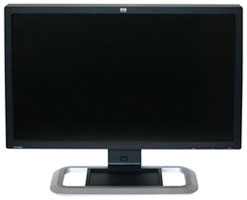 |
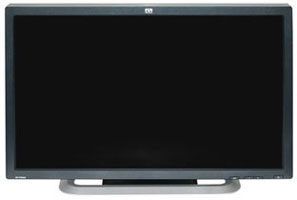 |
| Click to enlarge | |
The case exterior is an industrial black plastic, which ostensibly helps make the display more useful in multi-display environments. Besides, but is generally a neutral coloring for computer parts, and we think the display looks at least as good as any of the other LCDs we've used, from a purely aesthetic viewpoint. The side bezels are reasonably narrow, so if you're interested in setting up a massive multi-display work area (and you have the funds to support it) all you really need is a computer system capable of driving two dual-link outputs.
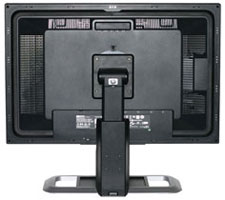 |
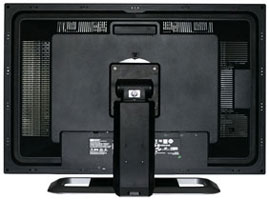 |
| Click to enlarge | |
As usual, there's not much to see on the rear of the unit, other than the VESA wall mount and model information/serial number. The input and power connections face the floor, but thanks to the height adjustment and a generous amount of tilt they are reasonably easy to access even after the display has been set up. The base stand feels quite sturdy, which you would expect of something designed to hold a 20+ pound panel. The panel locks into place when you slide it onto the base stand, and in order to remove the panel you have to push the release lever to the left or right. You can also tighten a hex nut to prevent the lever from being moved, effectively locking the panel into place.
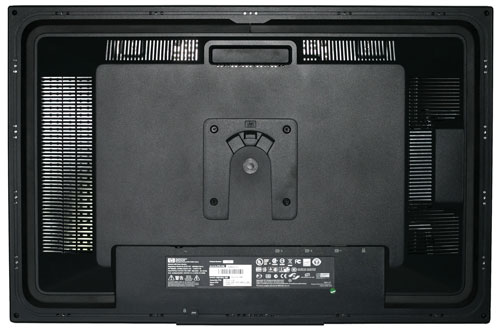 |
| Click to enlarge |
Here's another shot of the rear of the unit without the base stand installed. At the top of the display, there's also a pseudo-handle that can be useful when moving the panel around.
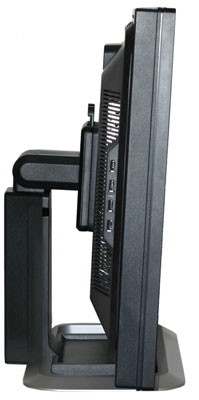 |
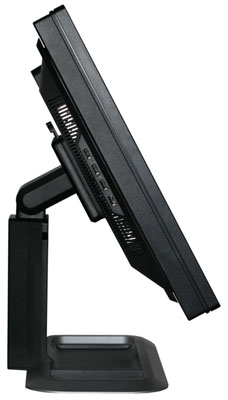 |
| Click to enlarge | |
Here you can see the left side of the panel showing the tilt mechanism in full swing, ranging from a 5° forward tilt to a 30° backwards tilt. You can also see the four USB ports.
 |
| Click to enlarge |
The major difference between the HP LP3065 on the other 30" LCDs on the market is, as previously mentioned, the number of input ports. For most others only include a single dual-link DVI port, HP includes three along with a mechanism to easily select between them.
In terms of controls, there are four buttons on the front of the panel: input select, decrease/increase brightness, and the power button. There is no on-screen display, which is typical of 30" LCDs. We would really like to see a 30" LCD that offered additional inputs (for example, component and VGA support up to 1920x1200 would be great), and the lack of an OSD has also puzzled us. The reason these features are provided is quite simple: there is at present no IC solution that provides for an OSD on 2560x1600 LCDs. That also explains why the single-link mode only functions that one fourth of the native resolution, because all scaling is handled by your graphics card and not by the LCD circuitry.
We have been told that an IC solution is in the works, and it is very likely that we will see future 30" LCDs that support on on-screen display and additional input options, as well as the ability to natively control image scaling. As the majority of people will prefer to run any LCD at its native resolution, such concerns are secondary. Still, it does prevent the 30" LCDs from being able to provide true multifunction support, which is a shame considering a 30" LCD could easily work as an HDTV.
We look forward to seeing future 30" LCDs (and perhaps even larger models) that are capable of supporting additional inputs. Considering the price and the dual-link requirement, we still feel that 24" LCDs are a better choice for most high-end users, and the 19"-22" offerings are great for the midrange and mainstream markets. Even entry level systems generally use 19" LCDs these days, with prices that are only moderately more expensive than the old 17" CRTs. If you are in the market for 30" LCD, however, the HP LP3065 is definitely at the top of the features charts right now.










44 Comments
View All Comments
gfisher - Sunday, July 26, 2009 - link
My HP machine has an NVIDIA 8500GT graphics card. I'm interested in buying a HP LP 3065 thirty inch monitor. Will the card drive the monitor at full speed?DaveJDSP - Sunday, December 30, 2007 - link
Jarred,I cannot possibly thank you enough for testing and posting photos of viewing angles. When doing critical photo/graphics work, it is essential that the top and bottom of the screen appear consistent from a fixed viewing point in the center of the screen. The larger the monitor, the more critical this becomes, as from a fixed point, the eyes scan over an arc of 10-20 degrees or greater.
Most monitors that I have seen at local stores have viewing angles that are totally unsatisfactory for critical work, even from a fixed eye point. And there are very few local stores that carry a sufficient selection of better and larger monitors, suitable for more critical work, so that the buyer can evaluate those monitors in person. Therefore, your complete and comprehensive reviews become even more critical.
Thank you again for your excellent reviews and for including such critical viewing angle information.
Dave
chakarov - Friday, March 23, 2007 - link
Contrast by specification shoud be 1000:1 but you measured it 585:1.It is interesting what to believe.
JarredWalton - Saturday, March 24, 2007 - link
As I explained in the Gateway FPD2485W review, contrast ratios, brightness levels, response times, and various other "spec sheet items" are often seriously exaggerated. While technically a higher contrast ratio is better, a 500:1 or higher real value is generally more than sufficient. There's also a possibility that at some specific setting the HP would come closer to 1000:1 - doubtful, given the results on the three tested settings (uncalibrated, calibrated, and print calibrated), but still possible.The basic issue is with backlight bleed - i.e. blacks that aren't actually black. In theory, any proper display would have an infinite contrast ratio, as black would be 0 and anything divided by zero is infinity/undefined. Some displays (the Acer, for example) achieve higher contrast ratios by having blacker blacks; others like the Gateway get them by having insanely bright whites. Anyway, more is not always better, as the color accuracy of the middle tones isn't represented by contrast ratio.
michal1980 - Thursday, March 22, 2007 - link
what about input lag vs a crt?crts should be the baseline since they seem to show close to 0 image lag.
lcd vs lcd is nice to, but if all lcds are off by a large number of frames from a crt, that will still suck
Souka - Thursday, March 22, 2007 - link
I feel a CRT vs LCD war thread starting..... ;)JarredWalton - Thursday, March 22, 2007 - link
LCDs are still slightly slower than CRTs, but we have abandoned the CRTs, or at least I have. I no longer have any for testing, and the last CRTs I purchased are now over two years old, the Samsung 997DF and the NEC FE991-SB. There hasn't been a new really high-end CRT released in upwards of five years, I don't think. Five or six year old 22" CRTs (with a 20" viewable diagonal) are better than the later 21/22" models in terms of features and performance. Then there's the whole geometry and signal adjustment that needs to be done on analog devices. Personally, I wouldn't even consider a CRT for my computer use anymore.Given that we have the 2407WFP for testing and it has been used already, we would prefer to continue with that trend. A baseline is just that: a reference point. Baseline doesn't have to be "best" - and obviously quite a few LCDs are better than the 2407WFP when it comes to input lag and response times. So far, however, we haven't seen more than a 1 frame (*maybe* two with the Acer AL2216W) difference in output. So the largest difference we've seen is currently less than 0.02 seconds.
Souka - Thursday, March 22, 2007 - link
Why not get a 30" Apple Cinema Display?AnnonymousCoward - Thursday, March 22, 2007 - link
Let's see, $2000 for the Apple versus $1274 for the Dell. If you like being charged up the @$$, then be my guest.Now, the Apple is competing with the LP3065 and 3007WFP-HC; those panels are superior and $300 cheaper retail. Not to mention I just bought the HC from Dell for $1430+tax. Why would you pay $570 more for a worse product?
dcalfine - Thursday, March 22, 2007 - link
YeaApple made the first 30" dual-link LCD for consumers and is often considered better than the Dell. It would be wise to consider it a contender.